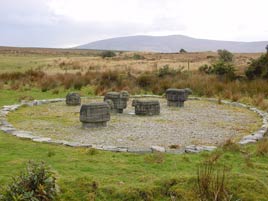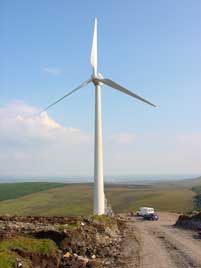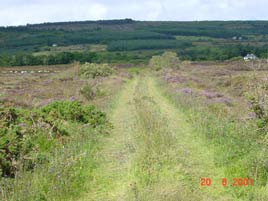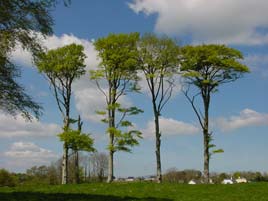From Castlebar - County Mayo -
How I Iearned to stop worrying and love Carbon
By Bowser
3, Jan 2002 - 18:17

Bellanaboy where the Gas Terminal will be located
|
Carbon is hot news nowadays with global warming, the Kyoto agreement and all that - and here in the West Enterprise Energy will soon be pumping lots of carbon compounds down their new gas pipeline. Assuming they get planning permission that is. The gas pipe will go right past Castlebar's doorstep and on to hook up to the old Kinsale gas pipeline to deliver the gas to Dublin. According to An Bord Gáis at the recent public hearing in Castlebar there will be no gas spurs to towns like Castlebar. It looks like the only direct benefit Mayo will get is the possibility of slinging a broadband optical fibre duct along the pipe - so that you will be able to read pages like this faster and cheaper than you can now.
Of course we will benefit nationally from reduced carbon dioxide outputs - the ESB will be able to close the large coal-fired Moneypoint power station on the Shannon Estuary if the new gas comes ashore. Burning methane directly in homes is much more energy efficient than burning coal in a power station which operate at perhaps only 60% efficiency. In big power stations one third of the energy content of the fuel is lost to the atmosphere at the power station - this has been facetiously called "space heating". Half the remainder is then lost along the transmission lines so that approximately two thirds of the fuel's initial energy content are lost if we generate electricity in large coal or oil-fired stations.

Low carbon emission energy source above Castlebar
|
Of course the windmills at Bellacorick, which are not too far from where the new Enterprise Energy plant will be located at Bellanaboy, will provide electricity without adding carbon dioxide to the atmosphere. While they can't provide reliable "base load" electricity, because they come to a halt on those calm cold winter days, there is increasing realisation that renewable sources will help us to kick our addiction to carbon-based fuels. We complain about G Dubya in the USA tearing up the Kyoto agreement - but in Ireland we have already gone way over our agreed Kyoto targets. In spite of the fact that we were actually allowed to increase our greenhouse gas outputs, the Celtic Tiger has taken that increase and then exceeded it by whopping percentage. It will get painful when Europe slaps daily fines on the government (read taxpayer) amounting to millions per annum - so we've got to break the carbon habit.
Being carbon life-forms though, we all have some affection for carbon. Diamonds are a girl's best friend - "get that ice or else no dice" - as Nicole Kidman put it in Moulin Rouge (not a mad MM imitation either). Pure carbon of course - the diamonds that is, not Nicole - and a lot more valuable than the €40 or so for a tonne of coal carbon suitable for a power station - more like €40 per milligram. A carat weighs 200mg so a one carat diamond will knock you back about €8000 or so - but talk to Paul Egan or Joe Murtagh for a more definitive price here in Castlebar!
A lot of the old uses for carbon are going out of style - coal on the fire, graphite in pencils, carbon paper in the typewriter - but new ones come along all the time. Charcoal or more specifically activated carbon is useful particularly in the West where the water can have high levels of trihalomethanes - chlorinated hydrocarbons such as chloroform, carbon tetrachloride, and a range of other chlorinated carbon compounds that are not good for you. We add chlorine to our drinking water to kill off bacteria and viruses that would definitely make us ill otherwise. The chlorine reacts with the organic matter in the water, however, which again is basically dissolved organic carbon in the water running off all our lovely peat bogs in the West.

Our bogs release dissolved carbon giving a peaty colour
|
The jug filters (Brita) contain activated carbon, which removes the vast bulk of these nasties - as good as boiling the water in fact. So if you drink water straight from the tap run it through one of these cheap filters first or boil it to evaporate these nasty carbon compounds off.
Carbon dating could be the most fun thing you can do with carbon - well maybe apart from taking your girl out for a meal and hiding a diamond in her soup! (groan!). Carbon dating is achieved by measuring the amount of radioactive carbon left in old plant material that once upon a time took carbon from the atmosphere such as old timbers in buildings or linen cloth - as in the case of the Shroud of Turin. The Shroud was dated to approximately 1355 AD by three different laboratories in 1988. They can tell how old an object is because radioactive carbon 14 disappears at a slow but steady rate. The old pine tree stumps down on the South West shores of Lough Mask, for example, are supposed to be something like 3000 years old - so there's some old carbon down there poking its head up out of the bog.

One hundred year old trees have one hundred rings
|
The dendrochronologists take dating to an even finer art by counting the annual rings on trees and matching up the rings on overlapping pieces of wood from different trees. They can go back continuously for something like 6000 years now with oak especially and each ring on an old piece of wood can be dated to a definite year. The explosion of the Santorini volcano in the Aegean has been dated to 1628 BC. The year before a large atmospheric dust event caused a late frost stopping tree growth which shows up very dramatically in the tree rings. This effect was also seen the year after the 1815 Mount Tambora eruption in Indonesia. Snow fell in June across Europe and North America that year and frosts occurred in July and August in New England. Farms were devastated, people went hungry and the disastrous summer of 1816 is supposed to have sparked off a whole wave of emigration from New England to the Midwest United States.
Next on the list... Nothing like nitrogen?
Previous element: Is Boron boring?
© Copyright 2002 by Castlebar - County Mayo -